Experience the magic of Java, Indonesia – Your Ultimate Travel Guide
Java – This region of Indonesia has intrigued me for as long as I can remember. Growing up in Odisha, a state rich with maritime history in the eastern part of India, we were regaled with stories of ancient voyages from our homeland to Java, Bali, and Sumatra. At that time, I had no idea how Java would be like if I ever got to see it in person. Then Java happened on our 11th anniversary this year. And oh boy, what do I even say about this wondrous island! Not one, not two, but home to a myriad of natural wonders, Java gifted us many once-in-a lifetime experiences on this one trip.
In a handful of days, we watched a surreal sunrise over an active volcano, then hiked to a mountain under a sky full of stars to watch a super rare blue fire and an enchanting yet acidic volcanic crater lake, climbed down a challenging path to witness the most magnificent waterfall that looked straight out of the Avatar world; And met the warmest and the kindest people at every step who made us feel like home. Java left us speechless, Literally!
If you want to experience the magic of Java like we did, here is our complete guide to help you plan your trip.
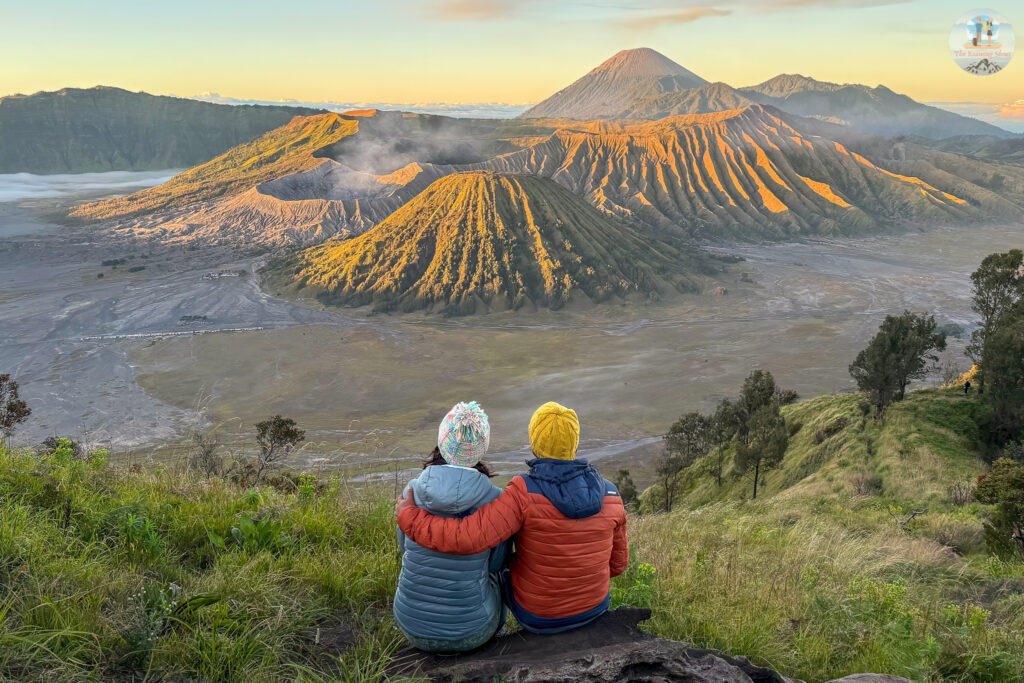
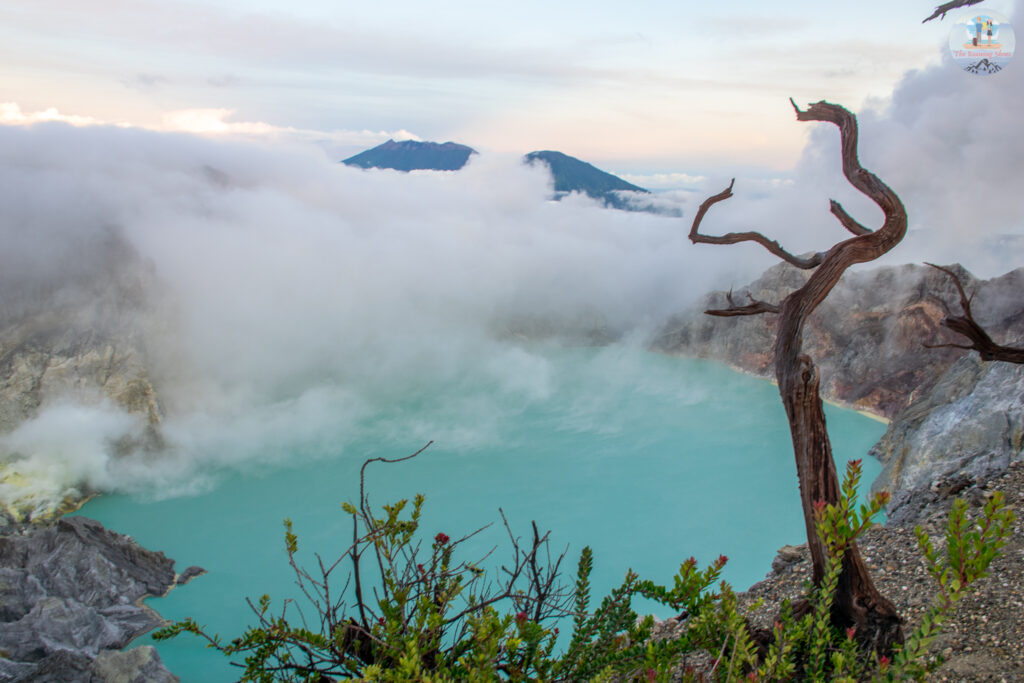
Good Time to Visit Java
The Dry season of May to October is ideal to visit Java with pleasant weather conditions and minimal rainfall. We visited during June 1st week and the weather was sunny and pleasant most of the time, except some rain on two afternoons. But it was not too bad and we were able to carry on with our outdoor plans.
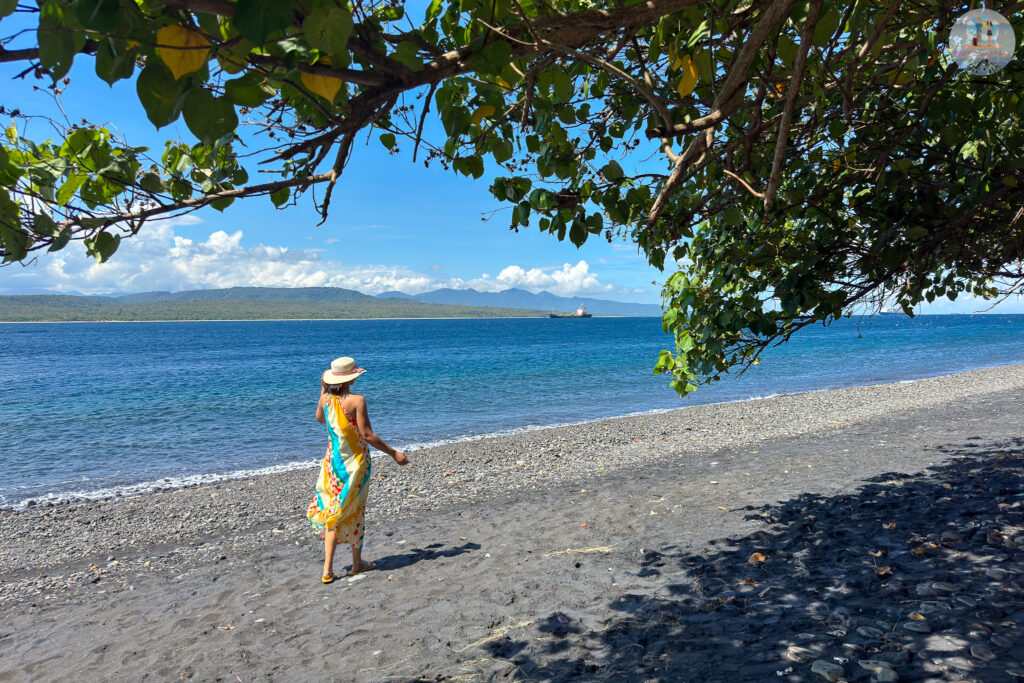
Time required and What to cover
Java is a large and diverse island with varied natural beauty, including an array of natural wonders, iconic historical sites, vibrant cities and rich cultural heritage. So the number of days required to visit Java largely depends on your interest and destinations you want to cover. But overall, 12-14 days is an ideal amount of time for exploring different parts of the island.
Since we had limited time (9 days) and were most interested in Ijen Crater, Mount Bromo and the temples, we zeroed on East and Central Java for our trip. If you have additional 3-4 days, then West Java can also be included in the itinerary.
Itinerary for East and Central Java
We finalised our itinerary after taking into account a lot of factors, including our time of arrival, entry and exit points, train schedule as well as tours planned. So you may have to tweak it a bit depending on your situation.
Out of the 9 days we had, 1 full day was simply gone in reaching our 1st destination (Banyuwangi) and last day of the trip was reserved for traveling back home. So we ideally had 7 full days, of which we spent 5 days exploring East Java and 2 days in Central Java.
Here is the itinerary we followed for our trip. Our entry and exit point for this trip was Surabaya.
Itinerary
Day 1: Arrival in Surabaya and proceed to Banyuwangi.
Day 2: Banyuwangi, East Java – Arrive in Banyuwangi. Trip to West Bali National Park.
Day 3: Banyuwangi, East Java – Ijen Tour. Later, explore local attractions in and around Banyuwangi.
Day 4: Malang, East Java – Train to Malang. Explore local attractions of Malang.
Day 5: Malang, East Java: Tumpak Sewu Waterfall Tour.
Day 6: Bromo Sunrise tour from Malang. Later proceed to Yogyakarta. Overnight at Yogyakarta.
Day 7: Yogyakarta, Central Java – Visit Borobodur and Prambanan temples. Explore local attractions of Yogyakarta.
Day 8: Yogyakarta – Day trip to Dieng Plateau. Evening at Maliboro Street.
Day 9: Yogyakarta to Surabaya. And fly back home.
You can find the itinerary breakdown with details of the places to visit in Part 2 of our blog: Java Travel Guide: Itinerary Breakdown & Insider Tips
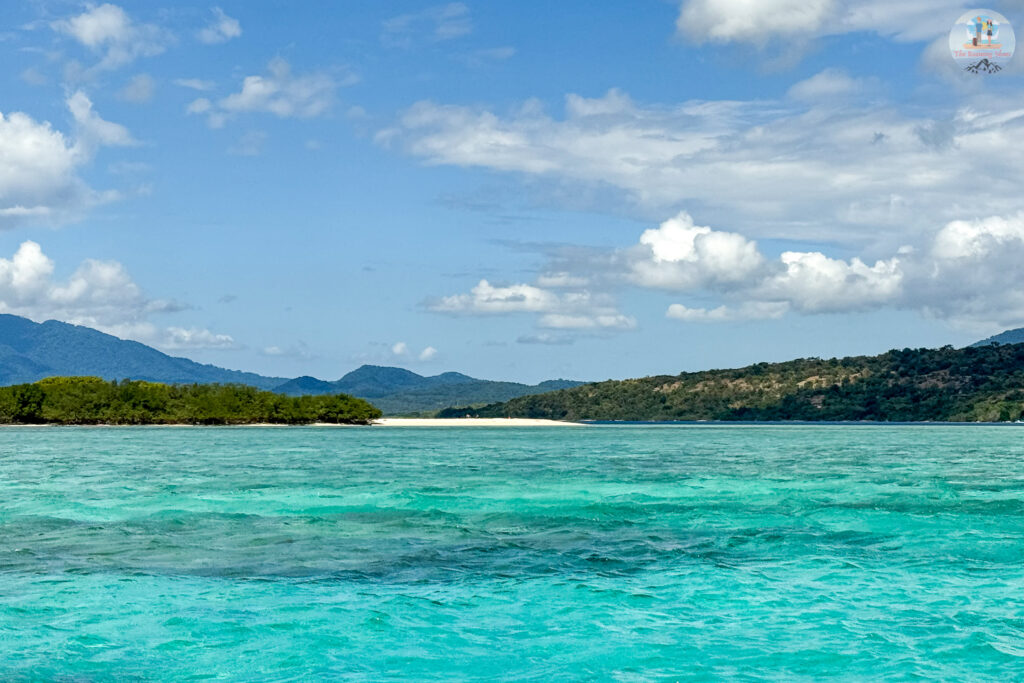
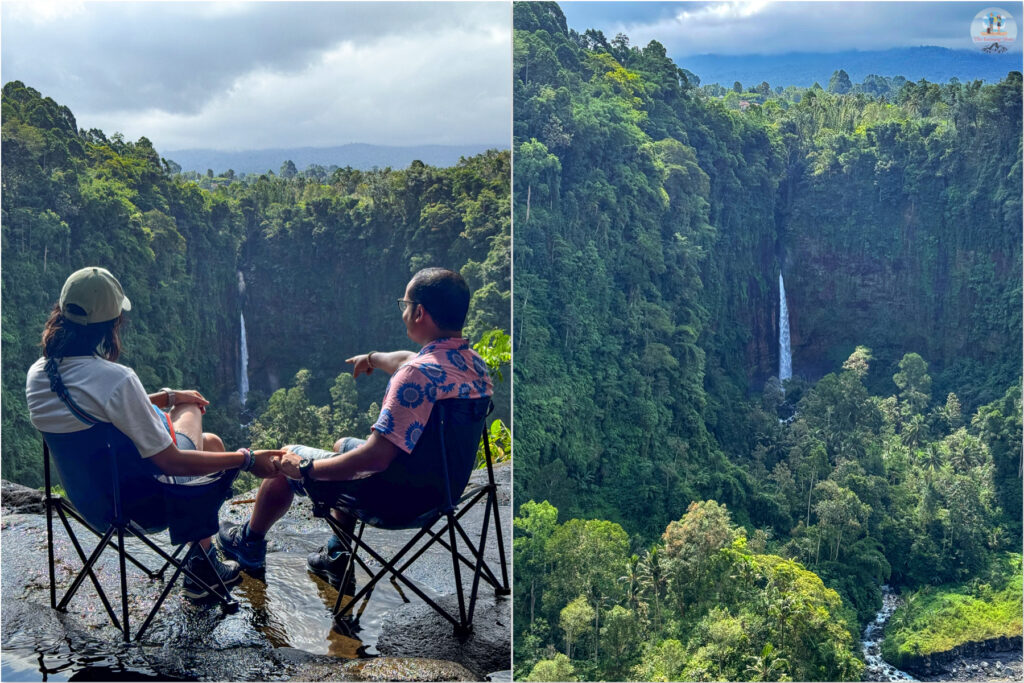
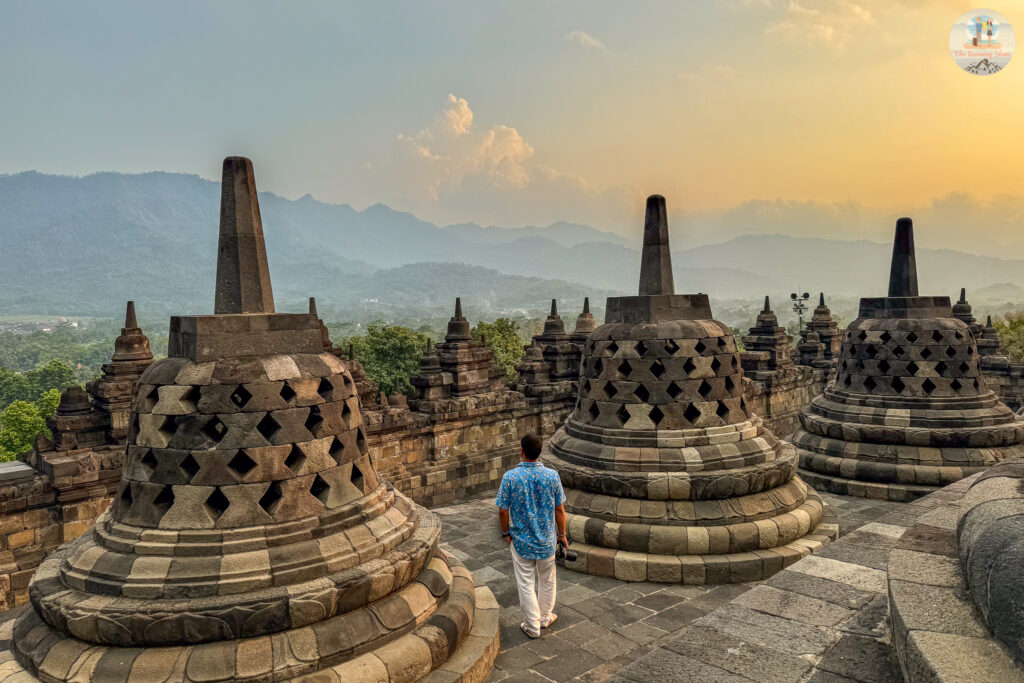
Visa Requirements for Java (Indonesia)
For Indians, both visa on arrival and e-Visa options are available. For convenience, I would recommend opting for the e-Visa to avoid waiting in queues at the airport. The e-Visa process is pretty straightforward and typically approved almost instantly after online submission.
You can apply for an e-visa through Indonesia’s official e-Visa website, where you’ll find detailed information on the required documents and charges. Nationals of other countries can also use the website to check visa requirements for their respective countries and apply accordingly.
Currency
The currency of Java is the Indonesian Rupiah (IDR). Unlike India, cash is the prevalent mode of payment in Java. From tour operators and guides to taxis, shop owners, and home stays, everyone typically requests cash payments. So, carry a substantial amount of cash. ATMs are readily available across Java if you need to withdraw more money.
In some places like restaurants and cafés, card payments are accepted, usually with an additional surcharge, which we found to be quite reasonable.
Reaching Java
Reaching Java is relatively straightforward, with several options available depending on your starting point and preference.
By Air
Java has 2 major airports, at Surabaya and Jakarta with good international connectivity. There is another Airport at Yogyakarta serving limited International flights, but very well connected domestically. Surabaya Airport (Juanda International Airport – SUB) is the gateway to East Java.
By Ferry
Regular Ferry services connect Java to other Indonesian Islands such as Bali and Sumatra. From Bali, it takes around an hour to reach Java by Ferry. So you always have the option to fly to Java and then return via Bali or vice versa.
Travelling inside Java
Train – For moving from one town to another
The train system in Java is the most comfortable and economical way to travel long distances. Book your tickets online in advance and you are all set. I recommend choosing the executive coach for a comfortable journey even though it is on the expensive side. With push back seats, extra leg space and blankets, it is the perfect choice for the long journeys, especially overnight trains.
However, some trains, like the one from Banyuwangi to Malang, only offer economy class. The main drawback of economy class is the limited leg space due to the seating arrangement, with two seats facing each other. On the bright side, the economy class fares are a fraction of what you would pay for a taxi over the same distance, making it a budget-friendly option.
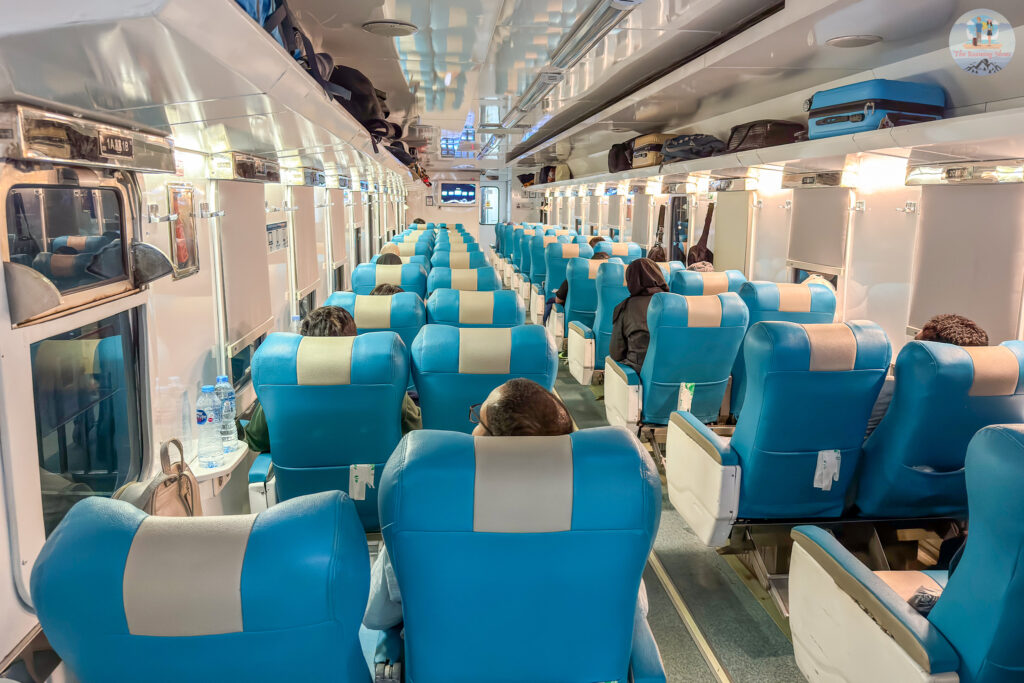
Train ride pointers
- Book your tickets via third party websites like tiket.com or traveloka.com if you are from outside of Indonesia. Kereta Api, the official railway site of Indonesia is not accessible outside of the country. Even though you access it via VPN, payment can not be processed unless you have an Indonesian card.
- Reach the station at least 30 mins before and print your boarding pass or physical tickets from one of the Kiosks. You will not be allowed to board the train without printing these.
- Have smaller luggages as larger bags and strolleys can not be accommodated in the luggage space overhead. And with not much space around, it gets difficult to accommodate the luggage.
- We found this amazing blog with detailed information on the train journey essentials in Indonesia. Do check it out for any queries.
Car with Driver for day trips
This is the ideal option if you prefer flexibility and personalization on your day trips over joining group tours. We chose this approach for our day trip to Dieng Plateau from Yogyakarta and for the waterfall tour from Malang, and found the cost difference with group tours to be minimal.
For hiring a car with driver, it is best to consult your accommodation first rather than booking directly through an agent. In our experience, the deal is always better when arranged through your place of stay. They can connect you with local drivers at a more competitive rate.
Grab and Becak for shorter distances
We found Grab both convenient as well as affordable for traveling inside the town. You can literally get the cabs anywhere anytime. Just install the app and you are all set.
Becak is another popular option for short distances. It is basically a cycle or motorcycle rickshaw with a capacity of 2 passengers. A little expensive compared to Grab, but the experience is quite unique. Evening rides are especially nice when it’s breezy.
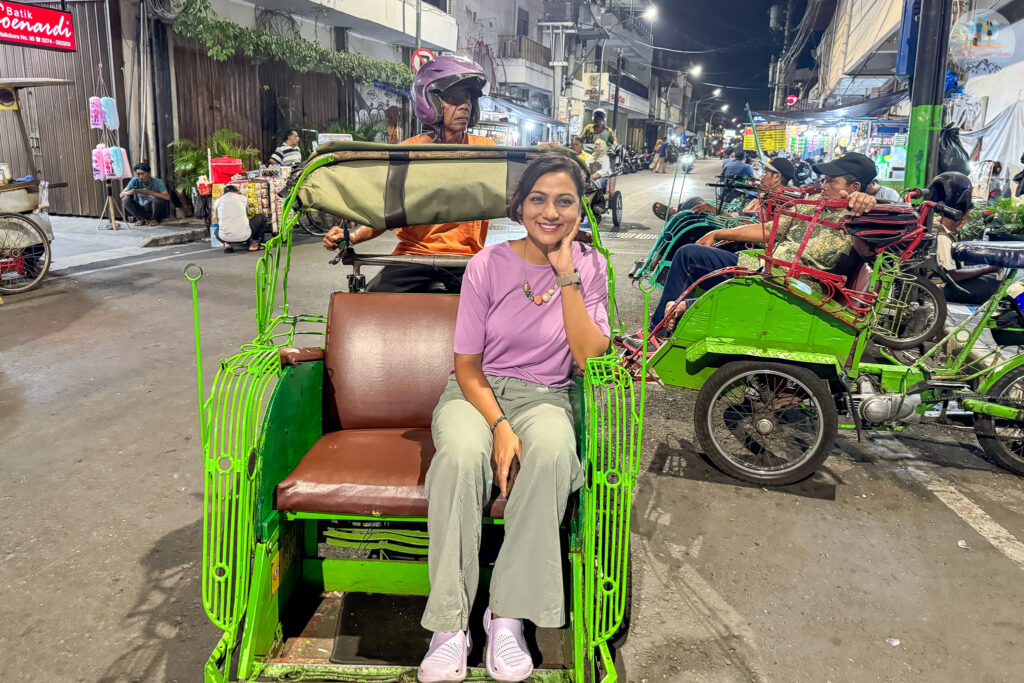
Accommodation in Java
Accommodation options in Java are plentiful, ranging from hotels across various budget brackets to economical hostels and cozy home stays and Airbnbs. However, if you ask me, I would advocate for home stays or Airbnbs over conventional hotels or hostels.
From our experience in Java, home stays offer the perfect opportunity to experience Javanese hospitality, fostering meaningful (and often funny and interesting) conversations with locals. Also, the hosts are very helpful in booking tours and local taxis. Thanks to our hosts, all our tours went smoothly, and we were able to get taxis at a cheaper price than what the operators quoted.
Here are the places we stayed, each comfortable with great hosts.
Banyuwangi
An economic stay in the heart of Banyuwangi. The room was simple, and clean featuring a private bathroom with all amenities. There is also a shared kitchen and dining area if you want to cook your own meals. The host’s sons live on-site and are very friendly and helpful. They helped us with our tours and were really sweet to pack us some Kue Ku for the Ijen trip. The host Harman himself was always very responsive to messages and queries.
Malang
Griyo Sultan Agung
This guest house is very conveniently located in a peaceful setting, just steps away from Malang Railway station. Jodipan colourful village is at a walkable distance from the guest house, so are many good cafés and restaurants. The rooms are clean and spacious with coffee/tea available in the common area 24/7.
What stood out as part of our stay was the attitude of the host and the welcoming nature of the staff. The host, Endah, is fluent in English and was very responsive, proactively assisting us with our queries. She organised our Bromo tour and arranged a car with driver for the waterfall tour at a very reasonable price. She was very kind to even ask one of her staff to drop us at the station when it started raining.
You can book this accommodation by contacting Endah on WhatsApp: +62 813-6022-8114
Yogyakarta
A small yet beautiful vintage property, aesthetic to the eyes and very comfortable for a stay. The location is great with walking distance from Sultan palace and close to delightful street food. And the best part is the person in charge who takes care of guests like family. She welcomed us with a smile and offered us tea when we reached late at night. Also, the taxi arranged by the guest house for our trip to Dieng Plateau was at a very reasonable rate. So if you are looking for a budget option with great location and personal touch, this is for you.
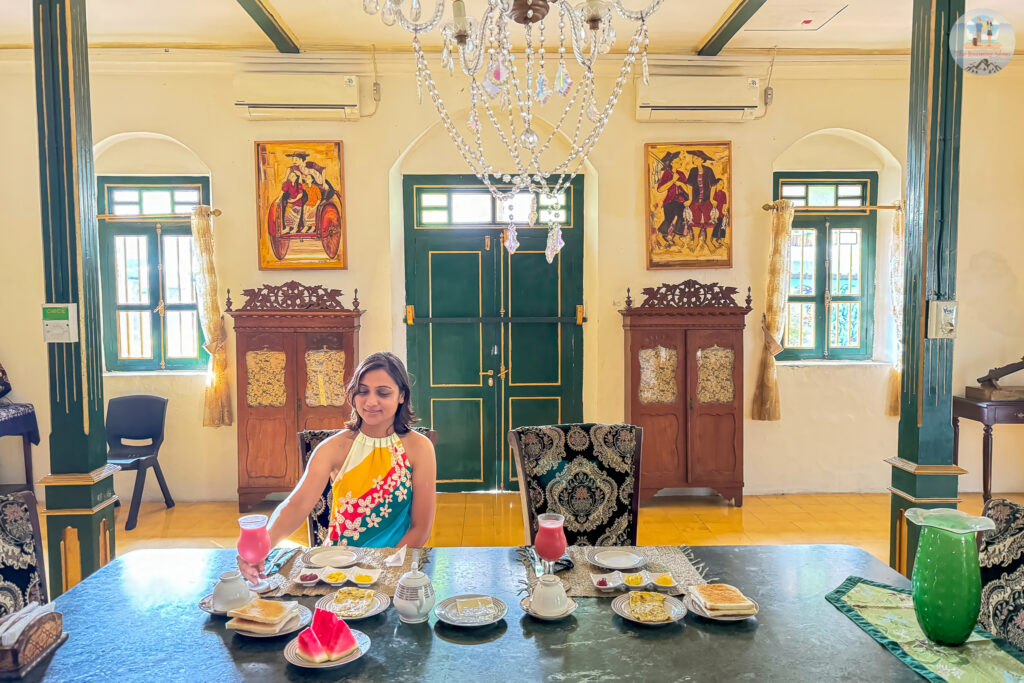
What to Eat in Java
Food in Java is absolutely tempting, especially the Street Food. And this statement coming from a non-foodie and someone with very sensitive taste buds says a lot about it’s taste and quality. The best part is many of these food items are vegetarian which was literally a blessing.
Street Food
Ronde
You will find this Ginger based soup in the road side stalls, mostly in the evening. The sweetish soup has small stuffed rice balls, a palm like fruit, roasted peanuts and breadcrumbs, perfect for cool evenings. We tried this in Yogyakarta from a stall outside our home stay and totally loved it.
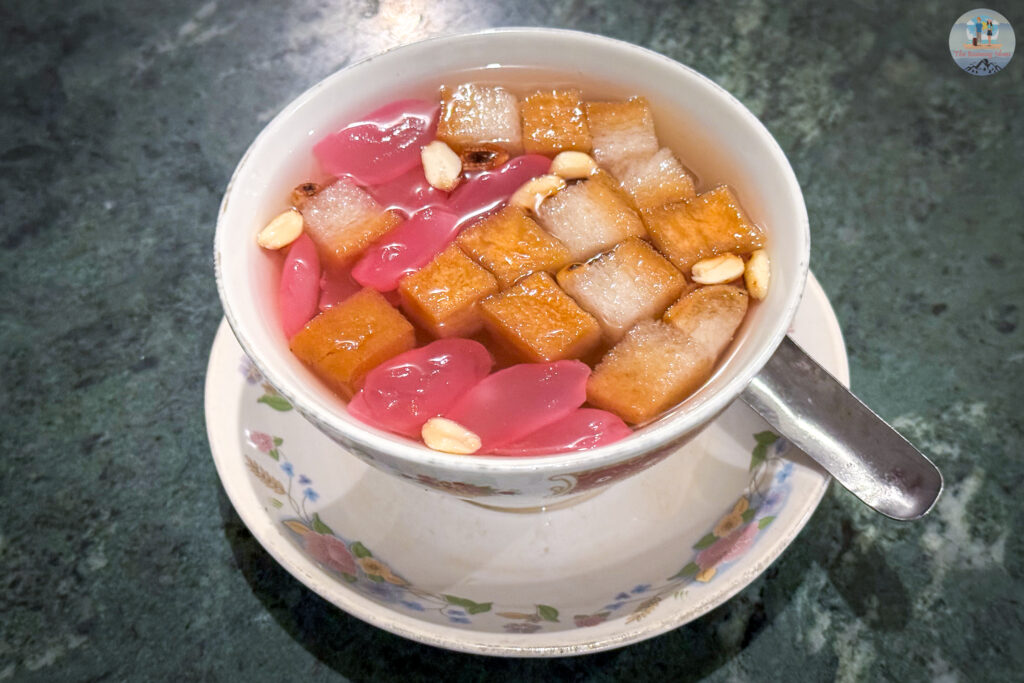
Kue Ku
Thanks to our homestay in Banyuwangi, we had the chance to taste these delightful sweet dumplings. Homemade by our gracious hosts, these oval-shaped treats can also be found in local shops. With their attractive red color, rice flour skin, and rich red bean paste filling, they taste absolutely heavenly.
Pisang Goreng (Fried Bananas or Banana Fritters)
The famous snack is made from ripe bananas coated in batter and then deep fried to perfection. I would never have imagined frying ripe bananas, but surprisingly liked its sweetish taste. You can get it at almost every street food stall in the morning.
Kue Rangin
A traditional snack or desert made of flour, sugar and grated coconut cooked on a specially molded pan on a stove. We tried this from the stall run by an elderly uncle by Telaga Warna lake in Dieng Plateau. The desert just out of the stove literally melted in mouth.
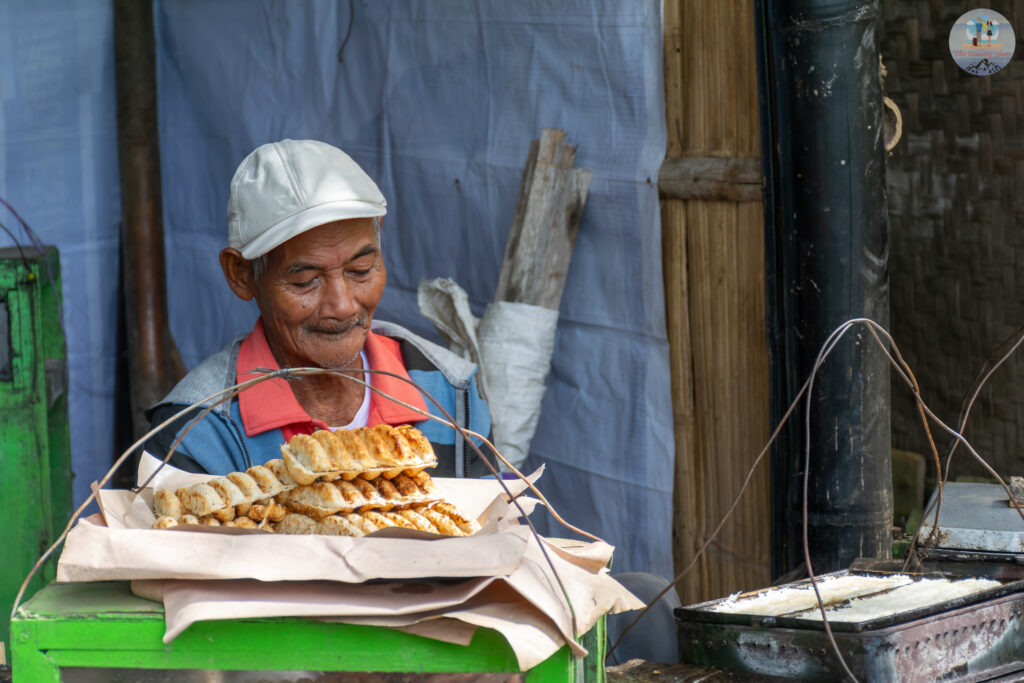
Traditional Local Dishes
Now other than these, there are many more local dishes to try in Java. Here are some of the popular ones. And the best part is many of them are vegan or vegetarian friendly.
Nasi Pecel
A traditional Javanese dish consisting of steamed rice, served with blanched vegetables and a sweet and spicy peanut sauce (called Sambal Pecel). Normally Nasi Pecel is garnished with fried savoury beef or tofu and tempeh (fermented Soyabean cake). So if you are a vegan or vegetarian, you can still enjoy this dish.
Nasi Gudeg
An authentic Javanese dish from Yogyakarta, made from raw jackfruit. The jackfruit is slow cooked with coconut milk, palm sugar and a mix of spices. Gudeg is normally eaten with rice and served with thick coconut milk (areh), fried chicken, egg or tempeh and/or tofu etc. So yes, my dear Vegans, you can try this dish too. You can find Gudeg almost everywhere in Yogyakarta. However, Wijilan, not too far away from the Royal Palace has many shops where the crowd gathers for Gudeg in the evening.
Nasi Goreng
This is not exactly a Javanese dish, rather something famous all over Indonesia. This is Indonesian version of Fried rice made with meat and vegetables. You can also find vegan version of this dish across the vegan cafés in Yogyakarta.
Soto Ayam
Again not limited to Java, but overall a signature soup from Indonesia. It is basically Chicken noodle soup with vegetables and a flavourful broth. Available in most of the restaurants and Warungs (small local eateries) in Java.
Sate (or Satay)
Skewered meat grilled on charcoal open fire and served with peanut sauce. You will find many street shops making it in the evening. Sate comes in different variations, most common being Sate Ayam (Chicken Satay) and Sate Kambing (Lamb Satay)
Other Must-try’s
Other than traditional food in Java, do try these too.
Snake Fruit (Salak)
Snake Fruit is grown abundantly in the region. It is native to Java and Sumatra and you can see the palm like trees loaded with these dark brown fruits more on the way to Kapas Biru Waterfall. The name comes from the outer layer of the fruit that resembles the skin of the Snake. Both Sush and I loved its taste and brought home a few. But it was love hate relationships for some of our family members :). So buy only if you like the taste and smell.
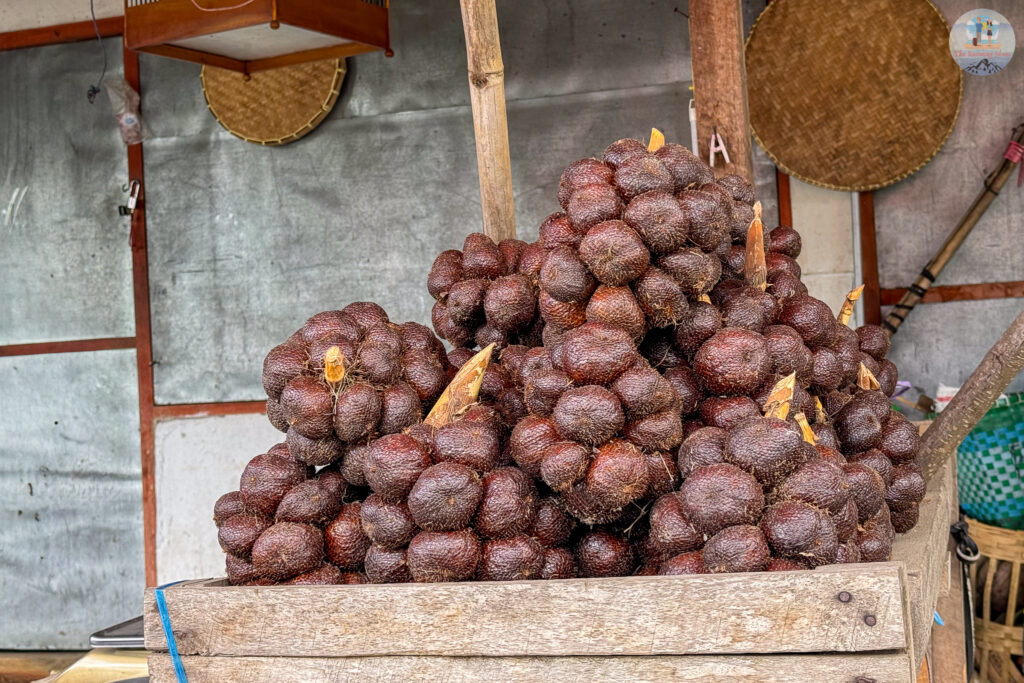
Banana Chips
The best I ever tried, the perfect crunchy snack on road trips. We bought one packet and literally finished it in a day. Wish we had bought more of these.
Java Coffee
You can’t leave Java without trying the famed Javanese coffee. Of all the coffee I’ve tried, the taste of Javanese coffee truly stands out. Even the instant packets mixed in hot water are rich and aromatic. If you’re feeling adventurous, try the famous Kopi Luwak, made from coffee beans collected from civet droppings. It’s considered the most luxurious and expensive coffee in the world.
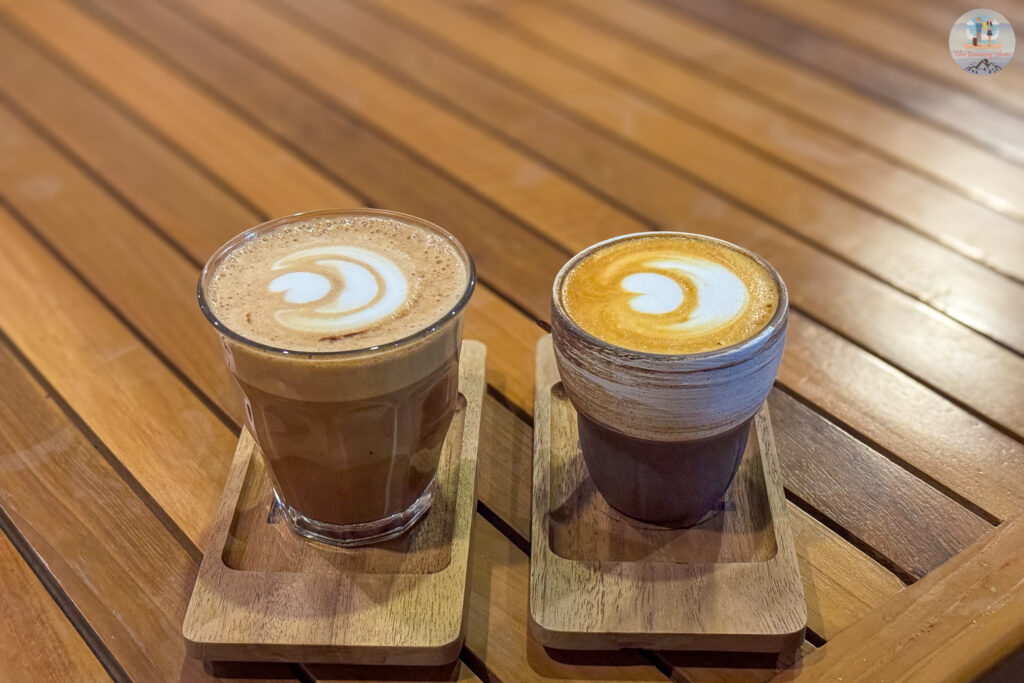
Where to Eat in Java
Now that I’ve shared all about the delicious foods, let me also tell you about a few places where we absolutely loved the food (and also the ones we did not like).
Banyuwangi
Srengenge Wetan
This place was recommended by our hosts for traditional Indonesian food, and it certainly did not disappoint. The décor, ambiance, food, and presentation were all delightful. With an extensive menu offering a variety of options, it’s the perfect spot for a relaxing dinner.
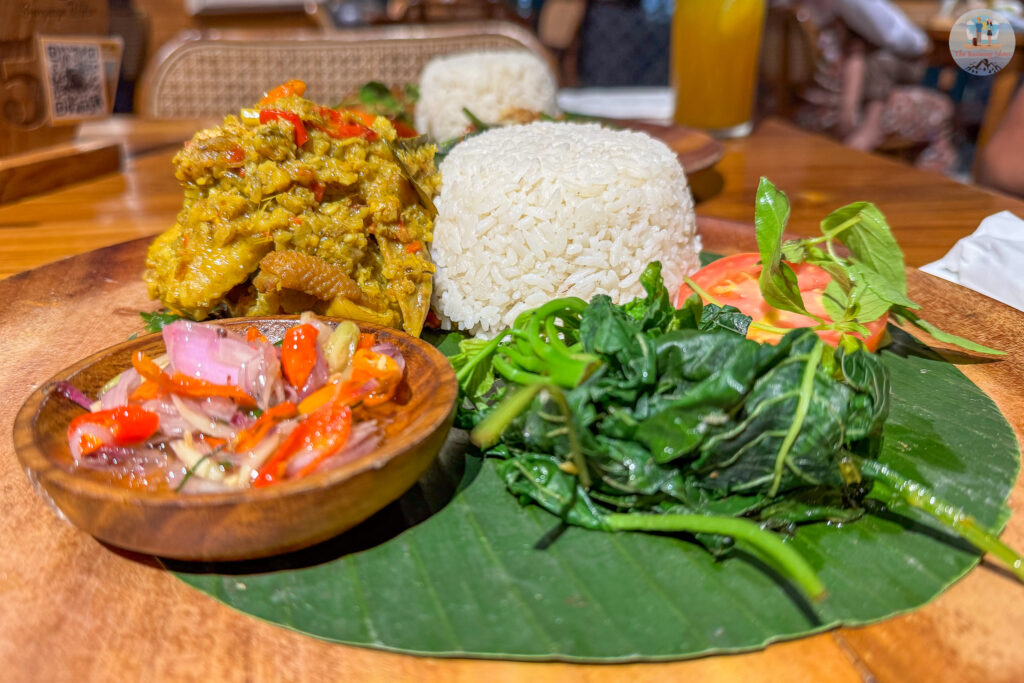
Navit Juice and Salad Bar
It is a small café with charming open-air seating. If you need a break from traditional food or are looking for a quick healthy brunch, this is the place for you. Despite the limited menu, their salads, juices, and smoothies are exceptionally good.
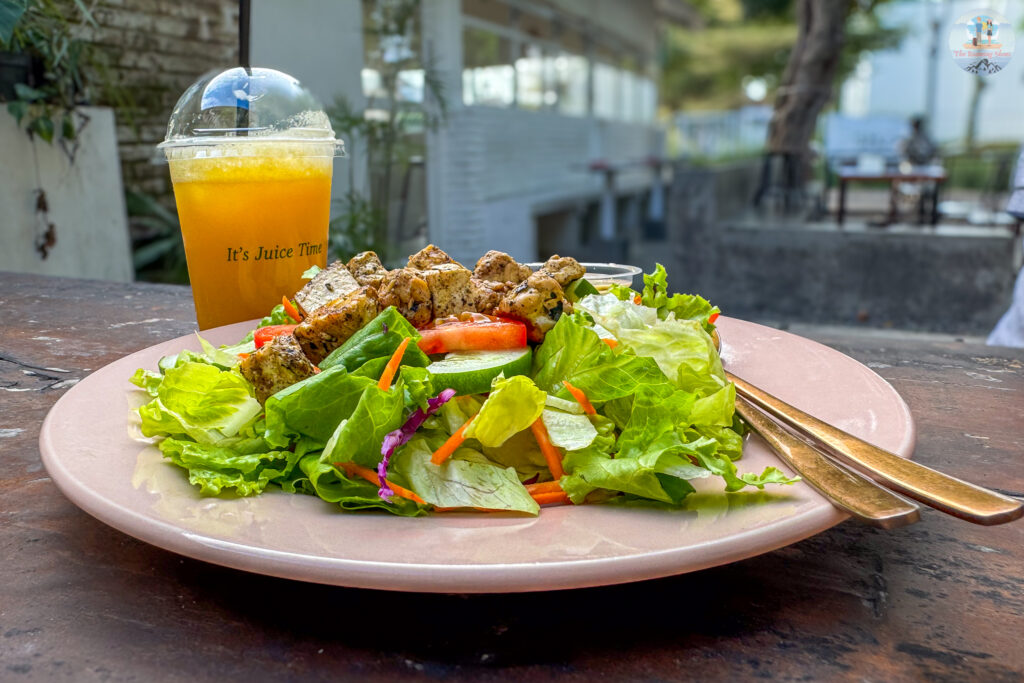
Deli Bakery, Resto and Gallery
Loved their fresh bakes and colourful sweet treats. Other than that, they also have a café upstairs serving both Western and Javanese food in a cozy setting. We tried their coffee, burger and pasta and the taste was good.
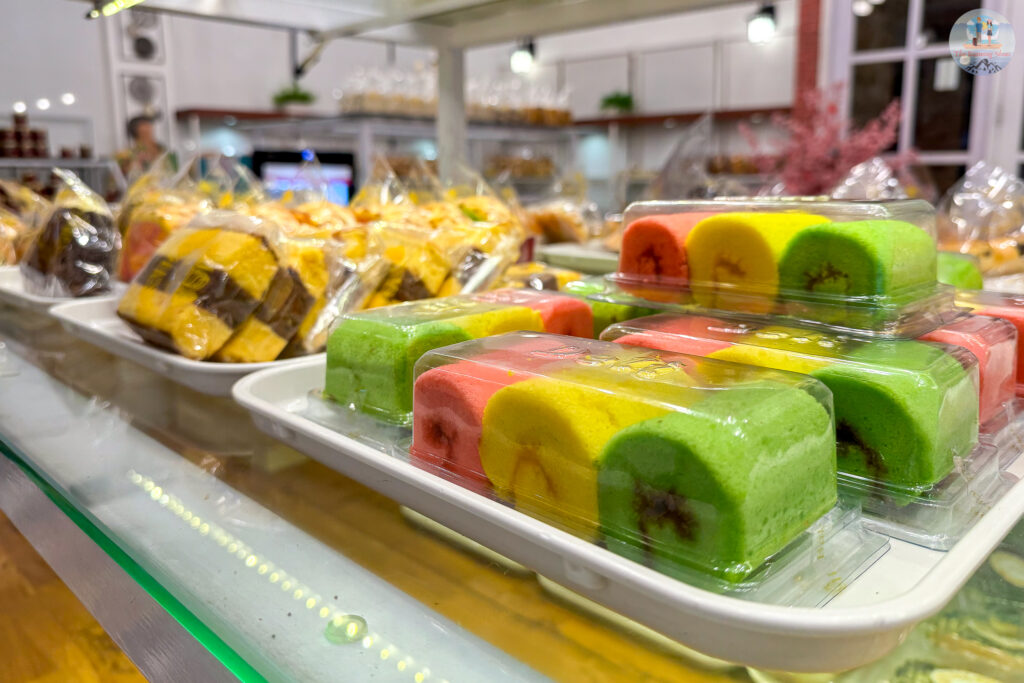
Malang
Java Dancers Coffee
A beautiful café set amidst lush greenery and with lovely open-air seating. They have a wide selection of cofffee with some unique flavours. So if you are looking for a place with good Western food and coffee, then this may just be the place. Sush tried the Norwegian Salmon Steak there and was quite impressed. They do serve some local dishes, though limited in choice.
There are 2 other places in Malang that we tried and were disappointed.
One is the restaurant in Hotel Tugu Malang, named Melati Restaurant. This one is considered a high-end restaurant and we definitely had better expectations. But the food was overpriced and tasted totally average.
Another one was Lafayette Coffee and Eatery which we decided to try based on its reputation for good dessert. But that was the biggest disappointment and I could not even finish it. The food tasted okay, but the hot drink was too sweet for my taste. The whole ordering process was chaotic and staff were indifferent. So, a totally underwhelming experience and I would not recommend.
Yogyakarta
Fortunate Coffee
Hands down, the best vegan food, and quite possibly the best food we had in Java. Fortunate Coffee offers a wide selection of dishes, both Western and Indonesian, at very reasonable prices. I tried the Burger Tempeh (Soy Patty), and it was even better than a typical veggie or chicken burger. Sush, who isn’t usually a fan of vegan food, loved his mushrooms and tofu rice bowl. The drinks were good as well. Highly recommended.
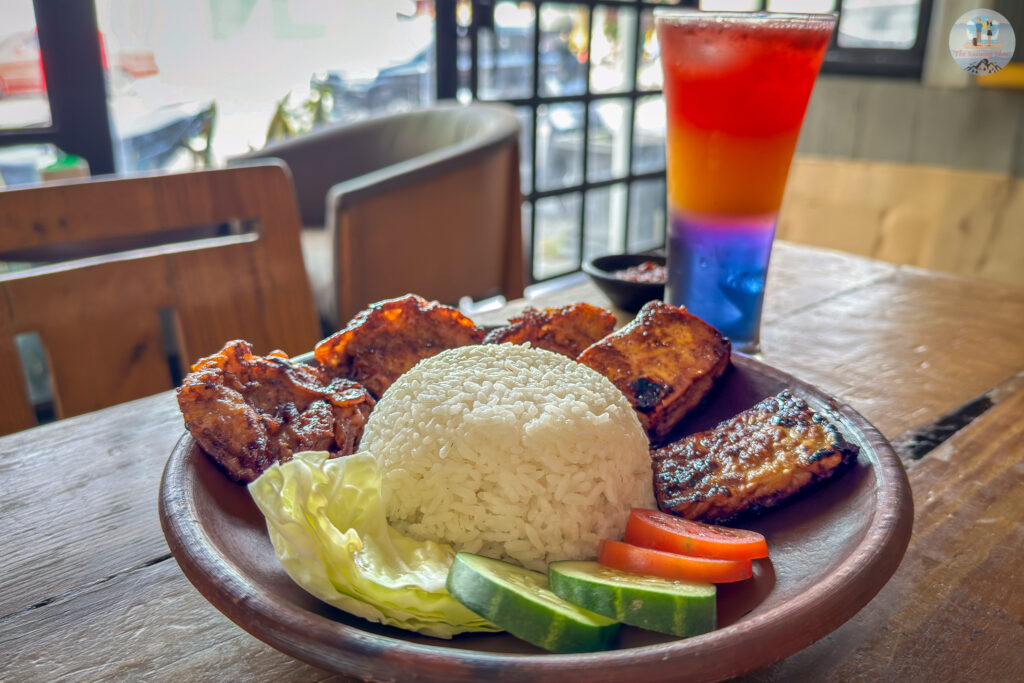
Blackforest Café
Another great vegan spot with a lovely ambiance and friendly, English-speaking staff. Blackforest Café offers vegan versions of many local dishes. Don’t miss the Orangeade if you’re in the mood for a unique hot drink—absolutely loved it.
Packing List for Java
This is one area I spent quite a lot of time on while planning for the trip. The diverse destinations and activities in Java required a versatile packing list. At the same time, we wanted to keep our luggage light for the train journeys, carefully considering what was really needed and what could be excluded. So here is my comprehensive packing list for Java to save you the trouble of research.
Warm Clothes
- A good wind proof Jacket: Bring a light windproof jacket with hoodie, even better if it’s waterproof. You will need this at Bromo and Ijen where temperature hovers around 7-12 degree Celsius and Ijen is often Windy. Jackets are available for rent at Bromo, but not at Ijen. So this is an item you must carry if you go by my principle of “Warm Me, Happy Me. Cold me, Cranky Me” 🙂
- Beanie: Again something you will need at Bromo and Ijen.
- Gloves: Optional, depends on your cold tolerance. I did not need it at Ijen, but at Bromo, I regretted not having it handy. Since it does not take much space, better pack a pair just in case.
Hiking Essentials
- A pair of good hiking shoes: This is an absolute must, despite taking up some space in your luggage. Proper hiking shoes with excellent grip are essential if you plan to hike Ijen. You’ll need them to navigate the uneven, boulder-strewn path into the crater and during the steep descent back.
- Headlamp (with battery to last at least 5-6 hours): A must for Ijen trip. If you book a tour, then the operator will provide head lamps and gas masks before starting the hike. But we recommend bringing your own headlamp as the ones given to us by the tour operator stopped working few mins in to the hike and it was really difficult to navigate in complete darkness with the help of our guide’s headlamp. For Bromo, normally it is not required unless you are trying to navigate to some lesser known viewpoint in the dark on your own.
- Waterproof Bag: Highly recommended for snorkelling or diving trips and waterfall tours. Also, if you are going to Tumpak Sewu, you will thank us for recommending this.
- Hiking Clothes: For Ijen, bring a pair of hiking pants or good leggings paired with T-shirts. Since it will be cold, a fleece lined pant is even better. For Tumpak Sewu, opt for comfortable clothing that dries quickly, because you’ll be getting wet from head to toe.
For the beach
- Swimwear
- Sarongs or cover ups
- Sunglasses
- Cap or hat
- Flip Flops
General Clothing
- Pack lightweight, breathable clothes, preferably cotton or linen, to stay comfortable in Java’s tropical climate. Include trousers, shorts, and a mix of comfy shirts and t-shirts.
- Bring one or two dresses and a skirt in bright colours for a vibrant touch.
- A lightweight shrug or poncho is perfect for the pleasantly cool mornings and evenings
Other Essentials
- Toiletries (Shampoo, body wash, moisturiser, shaving kit, toothbrush, toothpaste, face wash): If you are opting for home stays, carry all these items. Most of the home stays do not provide these, except for body wash, that too not always.
- Sunscreen: Definitely Yes. Java has a tropical climate with strong sun exposure throughout the day.
- Deodorant/ Perfume
- Personal Medications and basic first aid kit
- Wet wipes or Sanitising wipes
- Masks: With many people smoking around, a mask can be a lifesaver. It’s also essential for your Bromo trip, as the jeep ride through the sand makes it a necessity.
- Protein Bars: Throw in a few protein bars that would be a big help on the tours. The timings are so odd, you may get hungry on the way and have to survive on this. We literally did as we had to skip breakfast or lunch sometimes due to lack of time.
- Adapter: Bring an adapter supporting type C and type F plugs. Our adaptor for Europe worked perfectly in Indonesia.
- Power bank: Invaluable for day trips, especially if you frequently use your phone for taking pictures and videos
- Camera gears
Know before you go
- Java is not easy: It is true that Java is not for everyone. It is a destination that demands a certain level of physical fitness and endurance due to the sleepless nights, and extensive walking and hiking required to reach many of its attractions. However, if you are an adventure-loving soul and seek offbeat experiences, Java should definitely be on your list.
- Tip Culture: Tipping is not mandatory in Java and rather a choice if you liked the services. Even a small amount of 20000 IDR seemed to make people happy.
- Dressing: Java is a Muslim majority region. So the girls dress quite conservatively. Though they do not impose it on tourists, I would recommend dressing moderately and avoiding exposing clothes.
- Translator App: While some people in Java speak English, many do not, including Grab drivers, shop owners, and some local guides. That’s why a translator app is essential for smooth communication.
- Grab and Gojek Apps: Make sure to download and set up these apps before your trip. They are indispensable for hailing motorbike or car rides, as well as ordering food delivery. Both apps are user-friendly, reliable, and offer competitive prices.
- Public Smoking: Smoking is extremely common in Java. You’ll encounter people smoking almost everywhere, from guides on trips to cab and Becak drivers, and even people in cafés and restaurants. The pervasive smoke can be overwhelming, especially if you are allergic or sensitive to it, as I am.
- Photo Requests: We encountered a lot of people who requested me to take pictures with them, mostly families and ladies. It was a bit overwhelming, but most of them were very polite about it and some very kind. A girl insisted to pay for my coffee after I agreed to click a picture with her. So if you get such photo requests, just be patient with them.
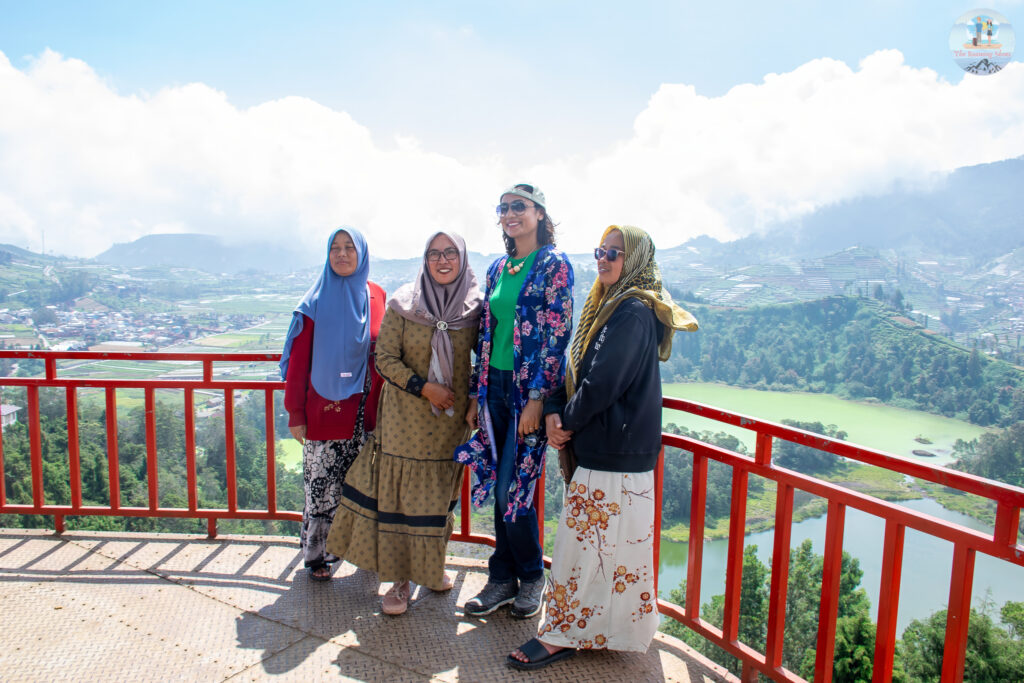
What we Loved about Java
The People
We found the people of Java very friendly and kind. And it felt quite safe even a little late at night (except a random hi from a passing motorbike). There were so many acts of kindness we encountered on this trip including people paying for our food or drinks to helping us out even before asking.
The Guides
Guides in Java are some of the most interesting and helpful people we’ve ever met. On top of that, they’re practically artists when it comes to taking pictures and videos.
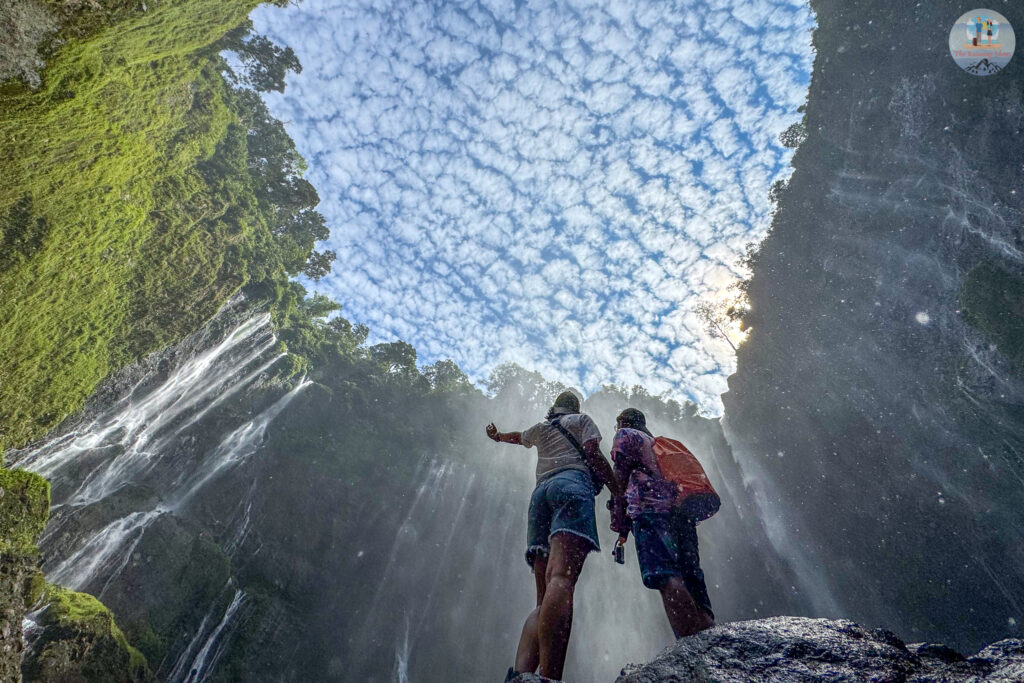
Java is Cheap
Food and accommodation in Java are quite affordable when compared to prices in Indian rupees. For instance, all our meals, including drinks, typically cost around 600-800 INR, even in good cafés or restaurants.
Street Food
Street food in Java is incredibly diverse and absolutely irresistible. Starting from Ronde, Satay (Sate) to local snacks and deserts, everything is freshly made and comes at a very reasonable price. I am not much of a street food person due to a sensitive stomach, but never had any issues in Java.
Train Journeys
This section would be incomplete without mentioning how wonderful train travel is in Java. Apart from the helpful staff and well maintained trains and stations, what we really liked was the scenic journey passing by the endless green fields, coffee and Papaya plantations and distant hills. Also, the stations are just too cute to miss, lined by bougainvilleas and other plants.
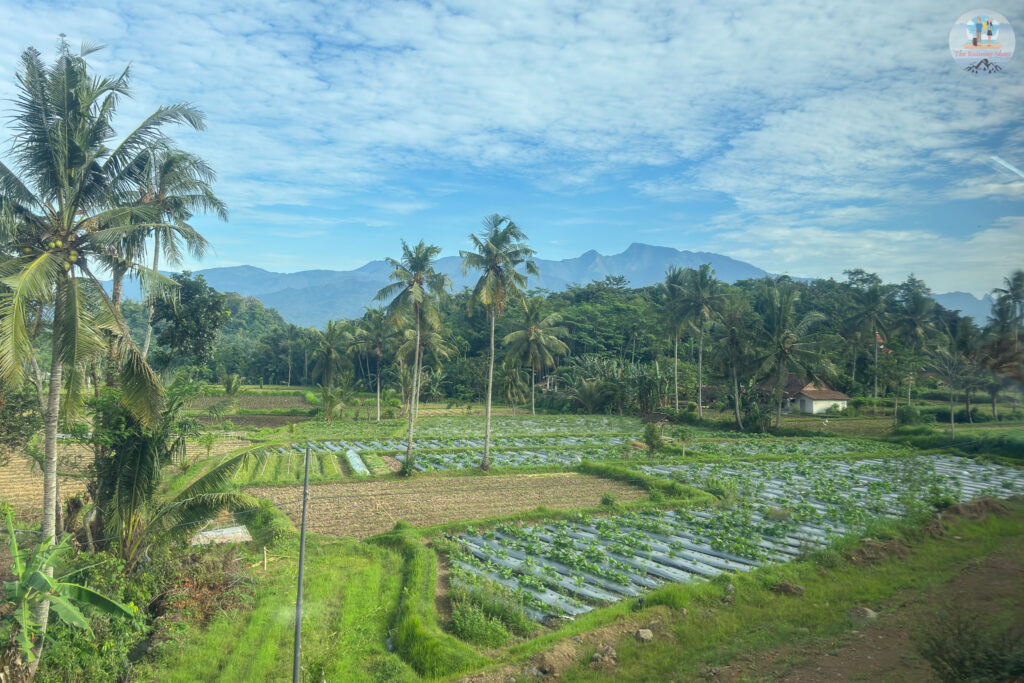
The Greenery and the Streets
This was my most favourite part of Java, the abundant greenery we could see everywhere, the green fields, the plantations and the forests. Not only that, even the streets in Java are lined by trees, with wide footpaths and squares adorned with vintage style lamp posts. So evening strolls in Java felt so refreshing.
Love for India
We were often approached by locals, sometimes even stopped by strangers on the road, curious about where we were from. Their faces would light up when we said India. They would immediately mention Bollywood movies, Shahrukh Khan, and their love for India. Some would even greet us with a “Namaste” or say “Shukriya” instead of “Thank You.” Our host in Malang mentioned that they rarely had guests from India and that her mother would be thrilled to take pictures with us. It was heartwarming to receive such genuine affection from strangers in a different country.
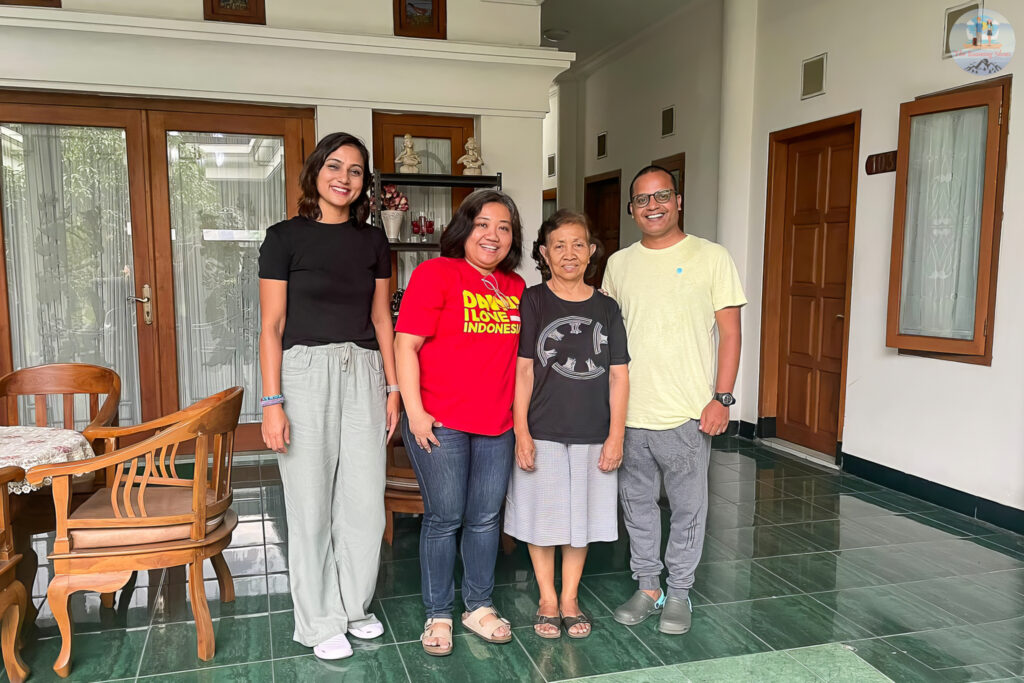
Conclusion
Java was truly a revelation. At every step, it surprised us and swept us off our feet with it’s otherworldly beauty. Many of the times, we had to ask ourselves if what was in front our eyes was real and often tears of happiness and gratitude welled up in our eyes. Now after visiting Java, I can say, there is truly no place like it and if you have the chance, you must visit it once in your life.
Hope our blog helps you plan that perfect trip to Java. For any queries related to Java, leave us a comment and we will get back to you as soon as we can.
Interested in more such places around the world. Read our other blogs here.



fantastic blog – i am now convinced to go to Java – can’t wait !! Thanks for all the amazing detailed info.
That’s wonderful to hear Barbara! Java is an incredible destination, and I’m so glad our blog could inspire you to visit. Wishing you an unforgettable adventure. Can’t wait to hear about your experience!
Cheers,
Ava and Sush
hi Ava and Sush.
I have read this article thoroughly.
I am very pleased with your excellent writing.
and, I would like to say thank you very much for visiting our beloved island, Java.
greetings from me,
Bayu from Yogyakarta.